Storage of Fine Woodchips from a Medium Rotation Coppice Eucalyptus Plantation in Central Italy
Abstract
:1. Introduction
2. Materials and Methods
2.1. Climatic Parameters
2.2. Storage Conditions
2.3. Physical Characteristics
- DML: Dry matter losses (%);
- DW1: Dry weight prior storage (kg);
- DW2: Dry weight after storage (kg).
- Wfb = Weight of the sample on fresh basis (g);
- Wdb = Weight of the sample on dry basis (g).
2.4. Chemical and Energetic Properties
- Final LHV = Lower Heating Value after storage;
- Initial LHV = Lower Heating Value before storage.
2.5. Statistical Analysis
3. Results and Discussions
3.1. Climatic Data
3.2. Particle Size Distribution
3.3. Moisture Content and Internal Heat Development
3.4. Dry Matter Loss
3.5. Fuel Characteristics
4. Conclusions
Author Contributions
Funding
Conflicts of Interest
References
- Spinelli, R.; Picchi, G. Harvesting Systems for Poplar Medium Rotation Forestry. In Proceedings of the 19th European Biomass Conference and Exhibition, Berlin, Germany, 6–10 June 2011; pp. 195–197. [Google Scholar] [CrossRef]
- He, X.; Lau, A.K.; Sokhansanj, S.; Lim, C.J.; Bi, X.T.; Melin, S. Dry matter losses in combination with gaseous emissions during the storage of forest residues. Fuel 2012, 95, 662–664. [Google Scholar] [CrossRef]
- Goyal, H.B.; Seal, D.; Saxena, R.C. Bio-fuels from thermochemical conversion of renewable resources: A review. Renew. Sust. Energ. Rev. 2008, 12, 504–517. [Google Scholar] [CrossRef]
- Iglesias-Trabado, G.; Wilstermann, D. Des Eucalyptus universalis, Global Cultivated Eucalypts Forest Map 2008. Version 1.0.1, GIT Forestry Consulting’s Eucalyptologics: Information Resources on Eucalyptus Cultivation Worldwide. 2012. Available online: http://git-forestry-blog.blogspot.com/2008/09/eucalyptus-global-map-2008-cultivated.html (accessed on 1 November 2019).
- Mughini, G. Suggerimenti per una eucalitticoltura clonale sostenibile nelle aree a clima mediterraneo dell’Italia centro-meridionale. Forest@-J. Silvic. For. Ecol. 2016, 13, 47. [Google Scholar] [CrossRef] [Green Version]
- Gasparini, P.; Tabacchi, G. L’Inventario Nazionale delle Foreste e dei Serbatoi Forestali di Carbonio INFC2005; Secondo Inventario Forestale Nazionale Italiano. Metodi e risultati; Edagricole-New Business Media: Milano, Italy, 2012; p. 653. [Google Scholar]
- Pignatti, G.; Verani, S.; Sperandio, G. Produzione di legna da ardere da cedui di eucalipto a turno breve: Produttività di lavoro e costi. Ital. For. Mont. 2019, 74, 218–226. [Google Scholar] [CrossRef] [Green Version]
- Lieskovský, M.; Gejdoš, M.; Messingerová, V.; Němec, M.; Danihelová, Z.; Moravčíková, V. Biological Risks from Long-Term Storage of Wood Chips. Pol. J. Environ. Stud. 2017, 26, 2633–2641. [Google Scholar] [CrossRef]
- Haughton, A.J.; Bohan, D.A.; Clark, S.J.; Mallott, M.D.; Mallott, V.; Sage, R.; Karp, A. Dedicated biomass crops can enhance biodiversity in the arable landscape. GCB Bioenergy 2016, 8, 1071–1081. [Google Scholar] [CrossRef] [PubMed] [Green Version]
- Pecenka, R.; Hoffmann, T. Harvest technology for short rotation coppices and costs of harvest, transport and storage. Agron. Res. 2015, 13, 361–371. [Google Scholar]
- Kühmaier, M.; Erber, G.; Kanzian, C.; Holzleitner, F.; Stampfer, K. Comparison of costs of different terminal layouts for fuel wood storage. Renew. Energy 2016, 87, 544–551. [Google Scholar] [CrossRef]
- Civitarese, V.; Spinelli, R.; Barontini, M.; Gallucci, F.; Santangelo, E.; Acampora, A.; Scarfone, A.; Del Giudice, A.; Pari, L. Open-Air Drying of Cut and Windrowed Short-Rotation Poplar Stems. BioEnergy Res. 2015, 8, 1614–1620. [Google Scholar] [CrossRef]
- Manfredi, S. Bilancio di Ciclo di Vita Energetico ed Ambientale di una Filiera Aziendale di Cippato da Short Rotation Forestry: Applicazione. Master’s Thesis, Università degli Studi di Parma, Parma, Italy, 2011. [Google Scholar]
- Pari, L.; Scarfone, A.; Santangelo, E.; Gallucci, F.; Spinelli, R.; Jirjis, R.; Del Giudice, A.; Barontini, M. Long term storage of poplar chips in Mediterranean environment. Biomass Bioenergy 2017, 107, 1–7. [Google Scholar] [CrossRef]
- Barontini, M.; Scarfone, A.; Spinelli, R.; Gallucci, F.; Santangelo, E.; Acampora, A.; Jirjis, R.; Civitarese, V.; Pari, L. Storage dynamics and fuel quality of poplar chips. Biomass Bioenergy 2014, 62, 17–25. [Google Scholar] [CrossRef]
- Jirijs, R. Effects of particle size and pile height on storage and fuel quality of comminuted Salix viminalis. Biomass Bioenergy 2005, 28, 193–201. [Google Scholar] [CrossRef]
- Kristensen, E.F.; Kofman, P.D. Pressure resistance to air flow during ventilation of different types of wood fuel chip. Biomass Bioenergy 2000, 18, 175–180. [Google Scholar] [CrossRef]
- Spinelli, R.; Pari, L.; Magagnotti, N. New biomass products, small-scale plants and vertical integration as opportunities for rural development. Biomass Bioenergy 2018, 115, 244–252. [Google Scholar] [CrossRef]
- UNI EN ISO 17225-1. Solid Biofuels-Fuel Specifications and Classes-Part 1: General Requirements. 2014. Available online: http://store.uni.com/catalogo/uni-en-iso-17225-1-2014 (accessed on 10 January 2020).
- Pari, L.; Scarfone, A.; Alfano, V.; Bergonzoli, S.; Suardi, A.; Lazar, S. Produttività dell’eucalipto-Un impianto quinquennale in Italia Centrale. Sherwood 2019, 241, 70–72. [Google Scholar]
- Spinelli, R.; Hartsough, B.R.; Magagnotti, N. Testing mobile chippers for chip size distribution. Int. J. For. Eng. 2005, 16, 29–35. [Google Scholar] [CrossRef]
- Eliasson, L.; von Hofsten Skogforsk, H. Effects of microchip production on chipper efficiency. Track #2–Non Peer-Reviewed Proceedings Paper. In Proceedings of the 41st Annual Council on Forest Engineering Meeting “Revolutionary Traditions, Innovative Industries”, Williamsburg, VA, USA, 15–18 July 2018; Available online: https://cofe.org/files/2018_Proceedings/Eliasson%20and%20von%20Hofsten.pdf (accessed on 10 January 2020).
- UNI EN ISO 18134-1. Solid biofuels—Determination of Moisture Content—Oven Dry Method Total moisture—Reference Method. 2015. Available online: http://store.uni.com/catalogo/uni-en-iso-18134-1-2015?___store=en&___from_store=it (accessed on 10 January 2020).
- UNI EN 15149-1. Solid Biofuels. Determination of Particle Size Distribution. Part 1: Oscillating Screen Method Using Sieve Apertures of 1 mm and above. 2010. Available online: http://store.uni.com/catalogo/en-15149-1-2010 (accessed on 10 January 2020).
- UNI EN ISO 18122. Solid Biofuels. Determination of Ash Content. 2015. Available online: http://store.uni.com/catalogo/uni-en-iso-18122-2016 (accessed on 10 January 2020).
- UNI EN 15104. Solid Biofuels. Determination of Total Content of Carbon, Hydrogen and Nitrose e Instrumental Method. 2011. Available online: http://store.uni.com/catalogo/uni-en-15104-2011 (accessed on 10 January 2020).
- UNI EN ISO 16994:2016. Solid biofuels—Determination of total content of sulfur and chlorine. Available online: http://store.uni.com/catalogo/iso-16994-2016 (accessed on 10 January 2020).
- UNI EN 14918. Solid Biofuels. Determination of Calorific Value. 2010. Available online: http://store.uni.com/catalogo/uni-en-14918-2010# (accessed on 10 January 2020).
- Hammer, Ø.; Harper, D.A.; Ryan, P.D. PAST: Paleontological statistics software package for education and data analysis. Palaeontol. Electron. 2001, 4, 9. Available online: http://palaeo-electronica.org/2001_1/past/issue1_01.htm (accessed on 10 January 2020).
- SIARL: Servizio Integrato Agrometereologico (Regione Lazio). Available online: http://www.arsial.it/portalearsial/agrometeo/index.asp (accessed on 1 February 2019).
- Wästerlund, I.; Nilsson, P.; Gref, R. Influence of storage on properties of wood chip material. J. For. Sci. 2017, 63, 182–191. [Google Scholar] [CrossRef] [Green Version]
- Pari, L.; Scarfone, A.; Santangelo, E.; Figorilli, S.; Crognale, S.; Petruccioli, M.; Suardi, A.; Gallucci, F.; Barontini, M. Alternative storage systems of Arundo donax L. and characterization of the stored biomass. Ind. Crop. Prod. 2015, 75, 59–65. [Google Scholar] [CrossRef]
- Lenz, H.; Pecenka, R.; Hartung, E.; Idler, C. Development and test of a simplified method to calculate dry matter loss during open-air storage of poplar wood chips by analysing ash contents. Biomass Bioenergy 2016, 94, 258–267. [Google Scholar] [CrossRef]
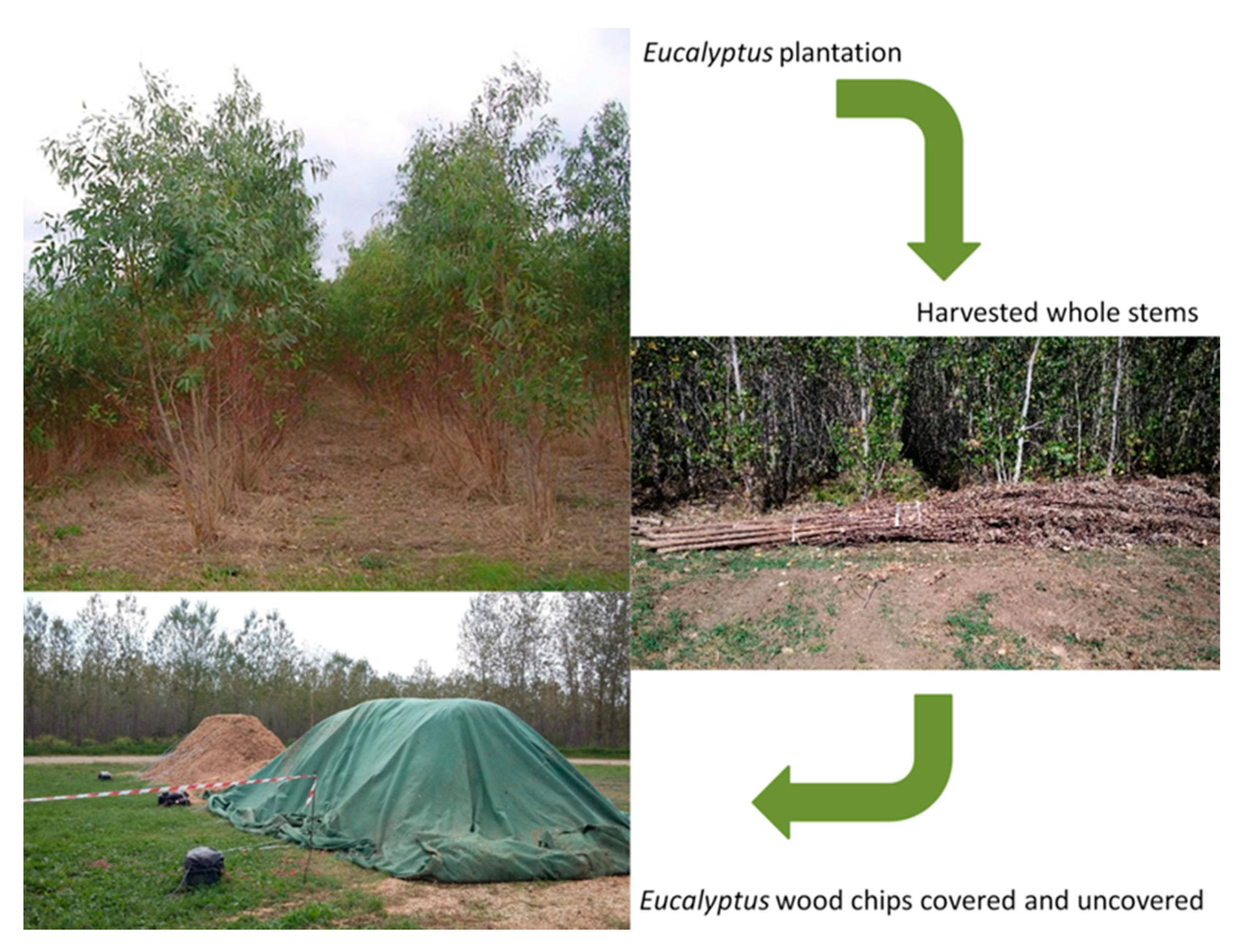
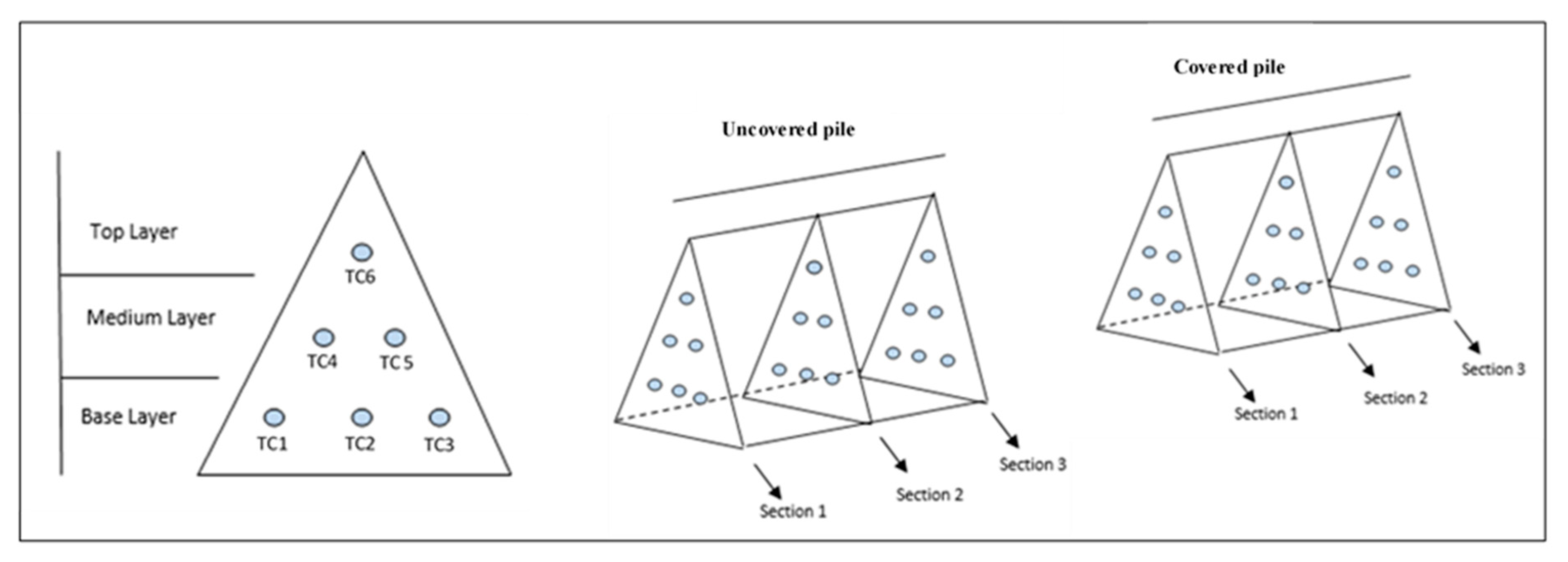
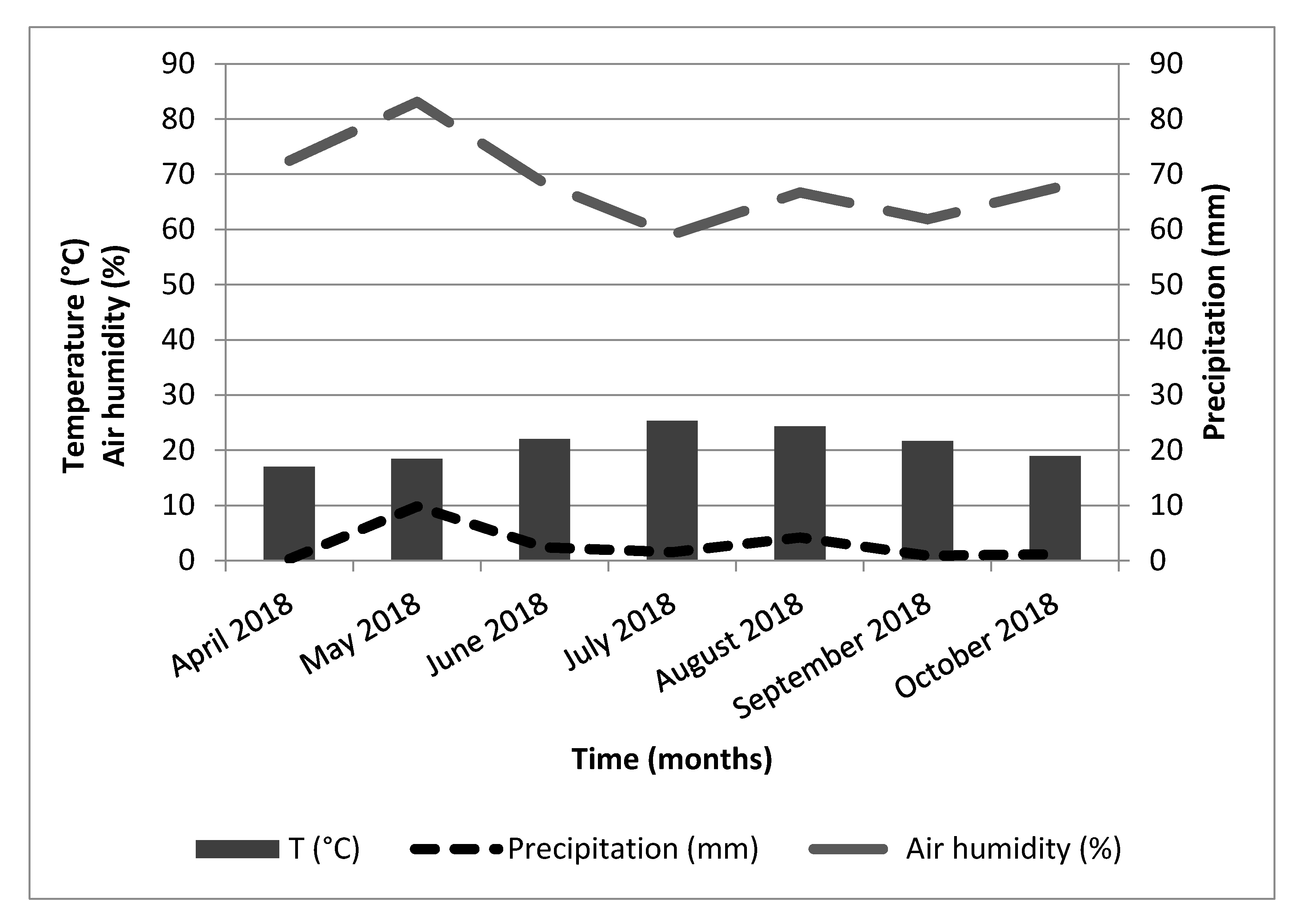
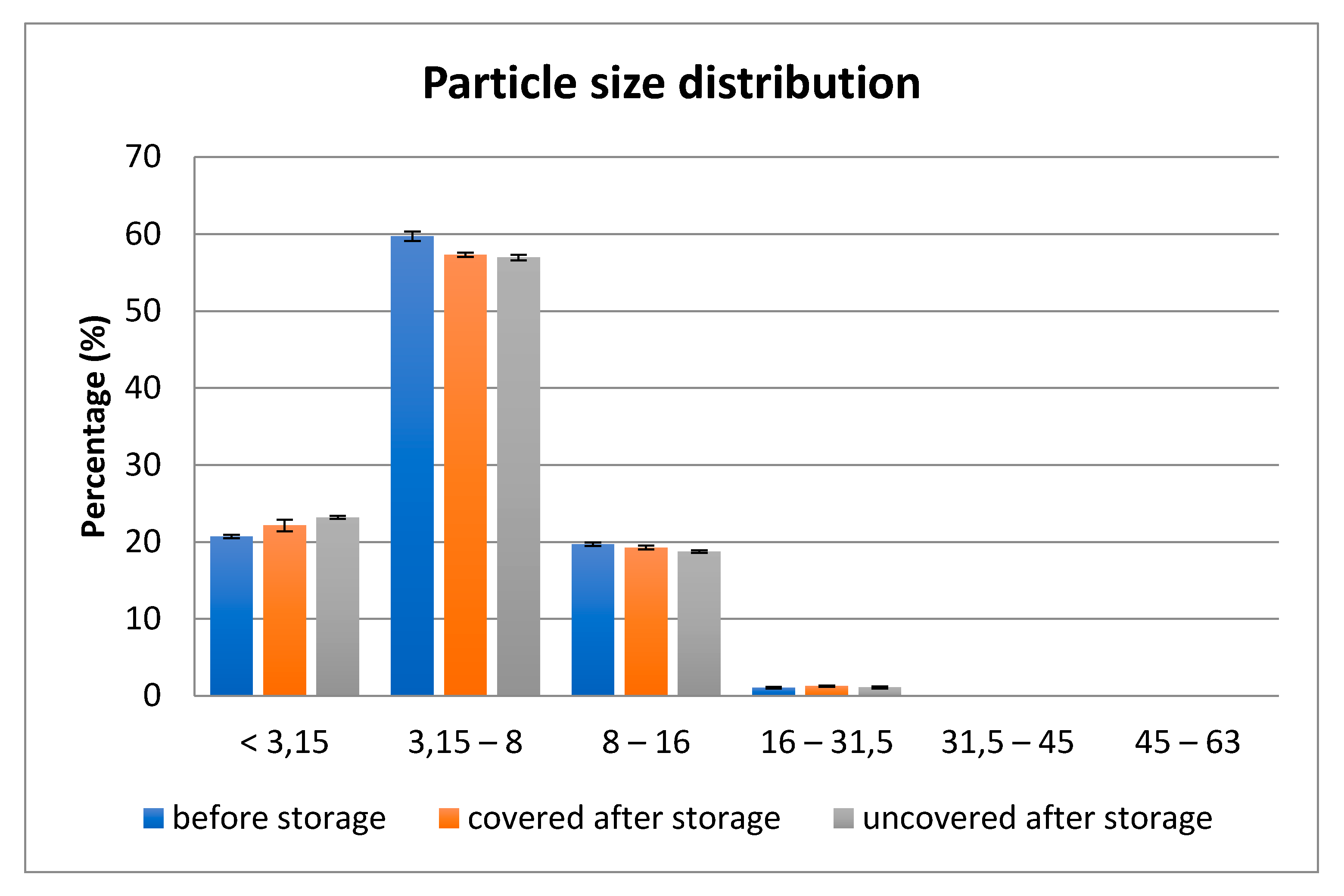
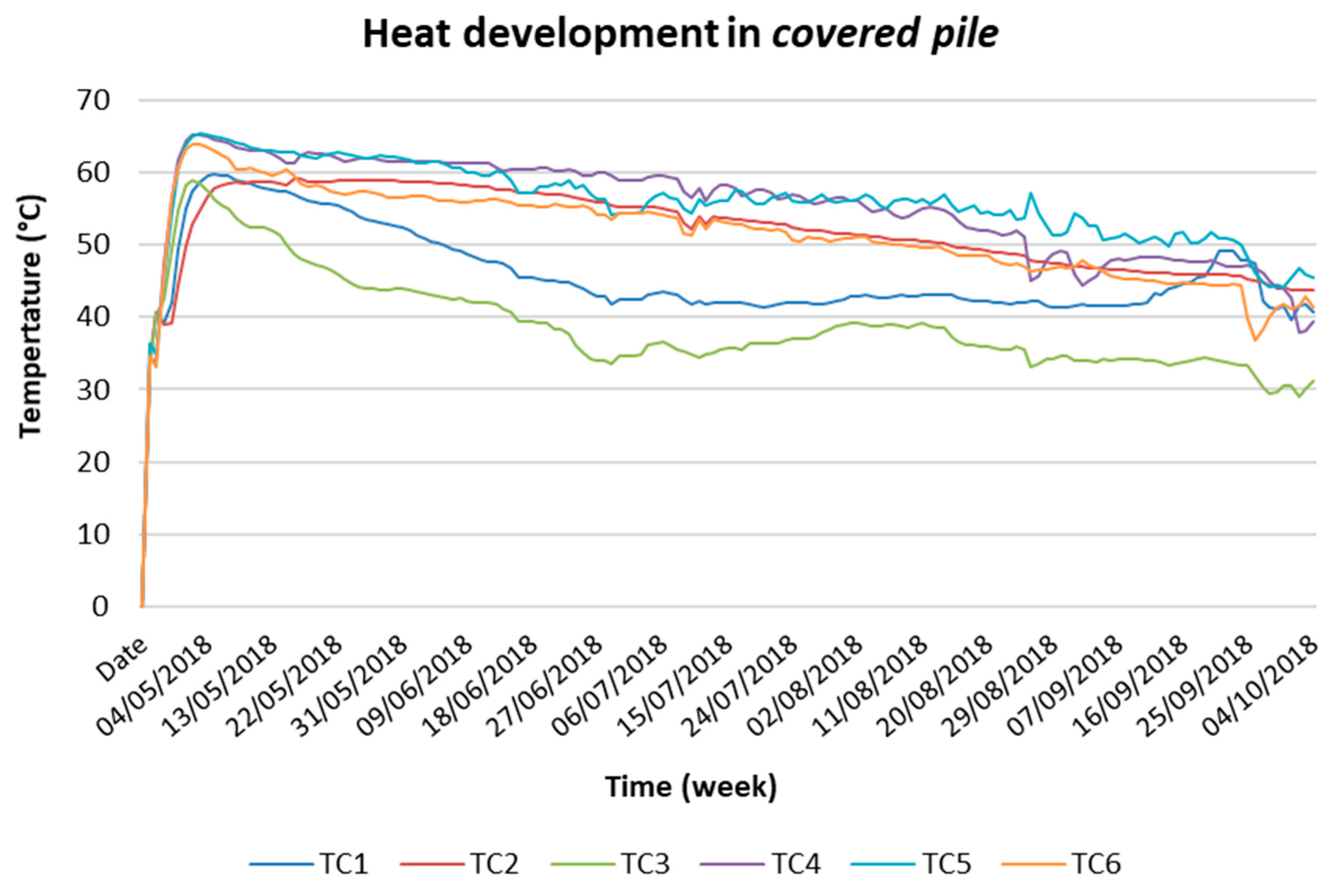
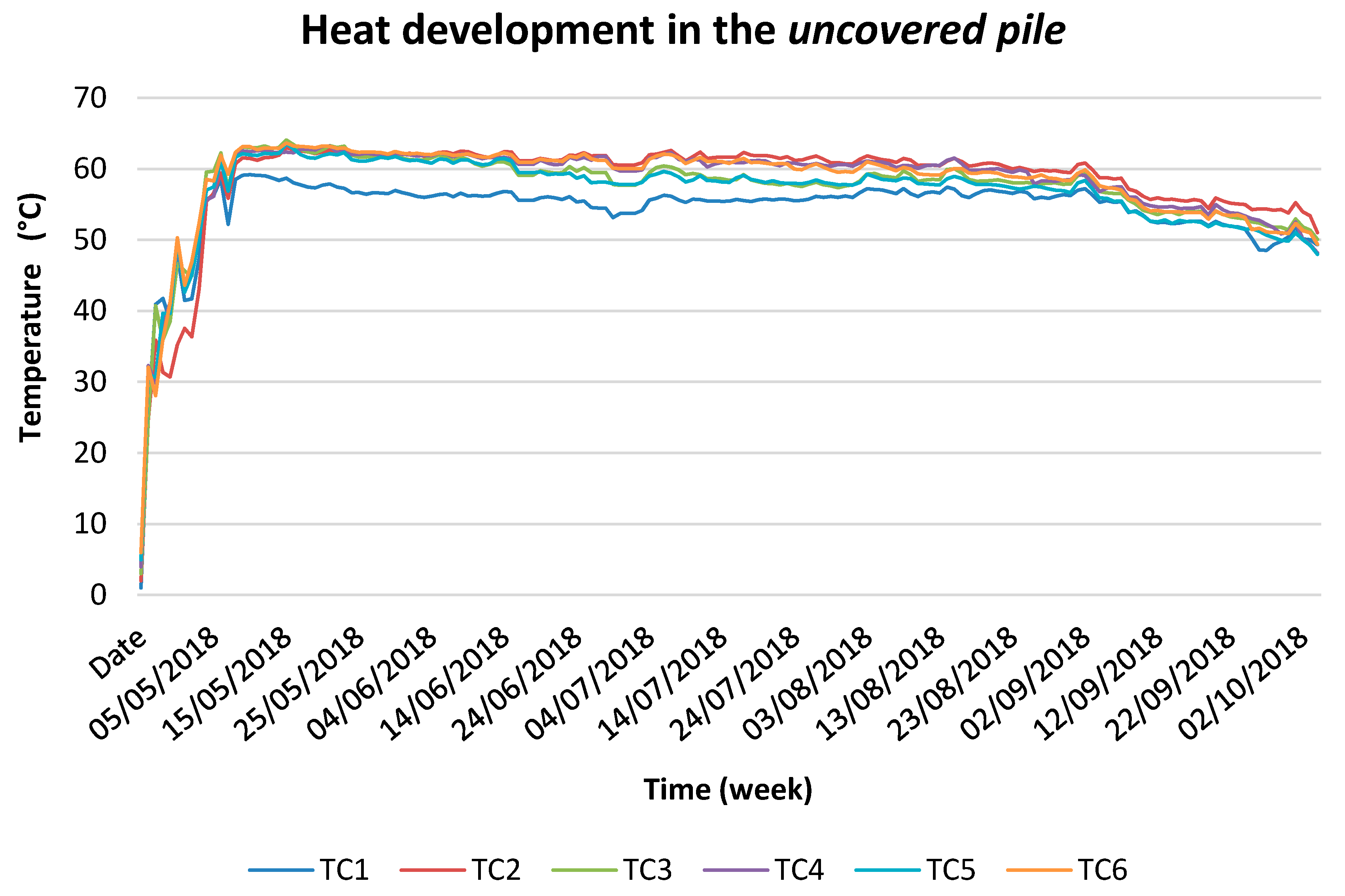
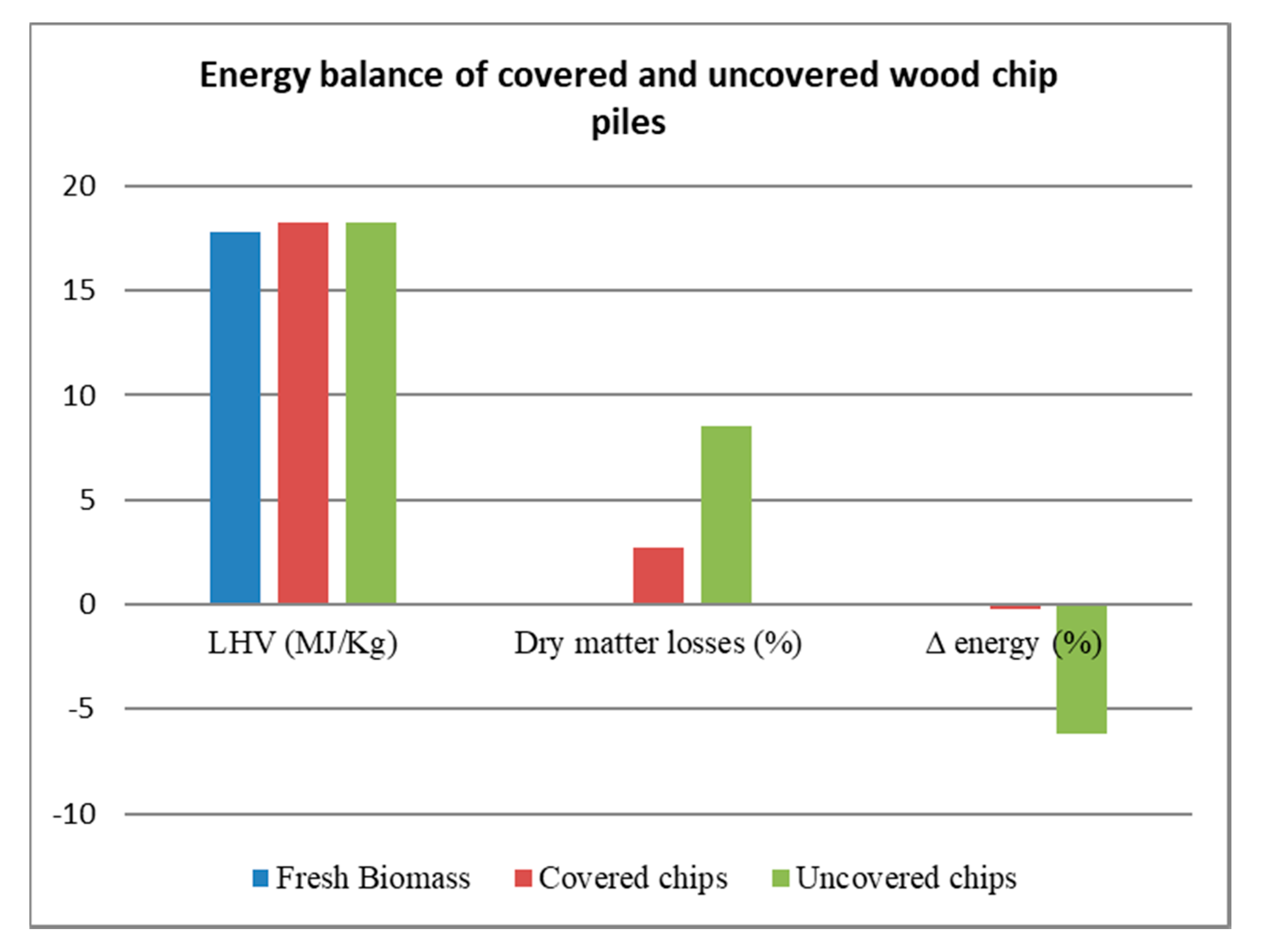
| Type of Storage | Replicas | MCi (%) | MCf (%) |
|---|---|---|---|
| Covered | 10 | 50 ± 0.13 a | 31 ± 8.45 b |
| Uncovered | 10 | 40 ± 4.88 c |
| Storage | DML (%) |
|---|---|
| Covered | 2.7 ± 1.7 a |
| Uncovered | 8.5 ± 4.7 b |
| Parameter | Unit | Fresh Biomass | After Storage Uncovered Chips | After Storage Covered Chips |
|---|---|---|---|---|
| Ash | % | 3.0 | 3.4 | 3.2 |
| Carbon | % | 47.8 | 47.4 | 48.0 |
| Hydrogen | % | 5.8 | 5.5 | 5.6 |
| Nitrogen | % | 0.32 | 0.50 | 0.30 |
| Chloride | % | 0.10 | 0.13 | 0.11 |
| Sulfur | % | 0.03 | 0.02 | 0.01 |
| Heating Value | ||||
| Higher heating value | kJ/kg | 19.035 | 19.440 | 19.439 |
| Lower heating value | kJ/kg | 17.773 | 18.228 | 18.225 |
© 2020 by the authors. Licensee MDPI, Basel, Switzerland. This article is an open access article distributed under the terms and conditions of the Creative Commons Attribution (CC BY) license (http://creativecommons.org/licenses/by/4.0/).
Share and Cite
Pari, L.; Bergonzoli, S.; Cetera, P.; Mattei, P.; Alfano, V.; Rezaei, N.; Suardi, A.; Toscano, G.; Scarfone, A. Storage of Fine Woodchips from a Medium Rotation Coppice Eucalyptus Plantation in Central Italy. Energies 2020, 13, 2355. https://doi.org/10.3390/en13092355
Pari L, Bergonzoli S, Cetera P, Mattei P, Alfano V, Rezaei N, Suardi A, Toscano G, Scarfone A. Storage of Fine Woodchips from a Medium Rotation Coppice Eucalyptus Plantation in Central Italy. Energies. 2020; 13(9):2355. https://doi.org/10.3390/en13092355
Chicago/Turabian StylePari, Luigi, Simone Bergonzoli, Paola Cetera, Paolo Mattei, Vincenzo Alfano, Negar Rezaei, Alessandro Suardi, Giuseppe Toscano, and Antonio Scarfone. 2020. "Storage of Fine Woodchips from a Medium Rotation Coppice Eucalyptus Plantation in Central Italy" Energies 13, no. 9: 2355. https://doi.org/10.3390/en13092355





